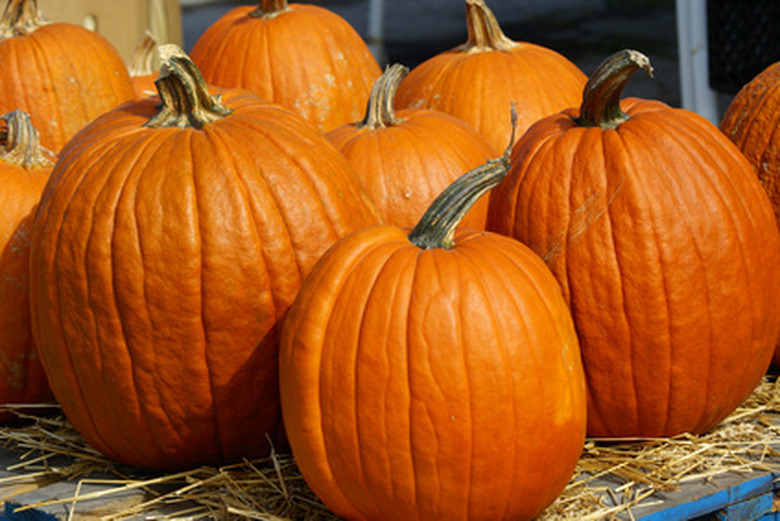The Planting Time For Pumpkins
Pumpkins, a form of winter squash (Cucurbita pepo) are annual vines native to the Americas. Appropriately, the pumpkin serves as a central piece of American fall festivals, including Halloween decorations and as sweet filling for Thanksgiving pie. Pumpkin vines are frost sensitive, so must be planted as seeds in warm soil and the 75 to 100 days following must not include freezing temperatures. Sow pumpkin seeds the same time you plant tomatoes outdoors in your region.
Planting Time
Sow pumpkin seeds or set out small pumpkin seedlings in spring after the last expected killing frost date and the garden soil is warmed to at least 65 degrees Fahrenheit. When gardeners in your region are planting sweet corn, watermelon, eggplant, pepper or tomato, it's also time to plant pumpkins. A fertile, organic-rich soil promotes the best growth and productivity of pumpkins. Do not plant in soggy areas or where flooding occurs after rain. Place both bush and vine types of pumpkins in full sun settings, receiving at least eight hours of direct rays.
- Pumpkins, a form of winter squash (Cucurbita pepo) are annual vines native to the Americas.
- Pumpkin vines are frost sensitive, so must be planted as seeds in warm soil and the 75 to 100 days following must not include freezing temperatures.
Regional Considerations
Although pumpkins appreciate heat, in regions with oppressively hot or long summers, pumpkins are planted so they do not grow in the core of summer. In Florida and the interior low deserts of California and Arizona, pumpkins are planted either from January to March or in August. These time frames allow the plants to flower and mature pumpkin fruits without stress from highest heat or excessive droughts. In coastal Southern California, pumpkins are planted in mid to late spring, April to June. Regardless, pumpkins are always grown during four-month periods of frost-free conditions.
Timing the Harvest
Besides not growing well in extremely hot conditions, gardeners in the United States in regions with long growing seasons often delay planting pumpkins. Looking at seed packets, you can deduct the number of days it takes for any pumpkin variety to grow to maturity and yield the orange fruits. You don't want pumpkins to ripen on the vine too early in the late summer or fall, since they might succumb to fungal rot and leaf diseases. Once the fruits ripen, the vine naturally deteriorates and dries up. Americans tend to want their fresh pumpkins from late September until late November.
- Although pumpkins appreciate heat, in regions with oppressively hot or long summers, pumpkins are planted so they do not grow in the core of summer.
- These time frames allow the plants to flower and mature pumpkin fruits without stress from highest heat or excessive droughts.
Planting Tips
Plant pumpkins in a spacious vegetable garden patch. Sow four to six seeds 3/4 to 1 inch deep in a planting hill. Multiple hills are spaced 6 to 8 feet apart. Once seeds germinate, thin out the plants so only two of the most vigorous remain. Vine-type pumpkins, such as ones that create large jack-o'lantern fruits, easily need 300 to 500 square feet of space. Even the bush-type varieties, which are better suited to gardens of limited size, still mature to more than 20 square feet.
